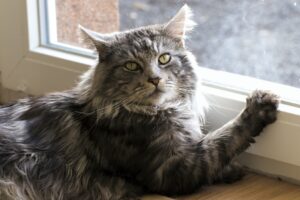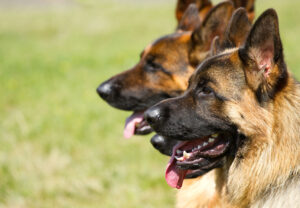NC State College of Veterinary Medicine Research Roundup, July 2021

A look at some of the latest published studies from the CVM.
Combatting Antimicrobial Resistance in Poultry
Multidrug-resistant Escherichia coli isolated from poultry workers, poultry and poultry farm environments in Abuja, Nigeria, are both prevalent and genetically related, highlighting the need to enforce antimicrobial resistance (AMR) regulations in the country.
Inappropriate use of antimicrobial agents in animal production has contributed to the development of AMR in foodborne pathogens, which can be transmitted from chickens to humans. The study’s findings suggest Nigerian authorities should prioritize prudent use of antimicrobials to limit the risk of transmission in the food chain.
Sid Thakur and Mabel Aworh are among the authors of the study, published in Antimicrobial Resistance & Infection Control.
Read the study here.

Canine Osteoarthritis Pain
The serum artemin is not correlated with sensitivity within dogs with naturally occurring osteoarthritis pain, though there may be a relationship between artemin and joint pain, according to new research.
Osteoarthritis pain is associated with peripheral and central sensitization in humans, leading to increased and widespread sensitivity across the body. Canine osteoarthritis pain shares characteristics with the human form of the condition. The study, published in Scientific Reports, is the first to investigate the relationship between artemin and sensitization in any species.
Study authors include Duncan Lascelles, Santosh Mishra, Jonathan Hash, David Knazovicky, Kinga Wa Chiu, Laura Minnema, Ludovica Chiavaccini and Ankita Gupta.
Read the study here.
Treating Heart Attacks
A minimally invasive exosome spray (EXOS) is a promising approach to deliver therapeutic exosomes for heart repair following a myocardial infarction.
Ke Cheng is part of a research team that, using a mouse model, determined that EXOS improved cardiac function, reduced fibrosis and promoted endogenous angiomyogenesis in a post-injury heart. ACS Nano published the research, with authors also including Ke Huang, Dashuai Zhu, Shiqi Hu and Junlang Li.
Myocardial infarctions, or heart attacks, are the most common cause of death worldwide. One American experiences a myocardial infarction about every 40 seconds.
Read the study here.
Feline Hypertrophic Cardiomyopathy

Two genetic variants associated with the hypertrophic cardiomyopathy (HCM) phenotype in two feline breeds were absent in other types of cats in a new study.
HCM is the most common cause of heart disease in domestic cats and some breeds are genetically predisposed to the condition. The variants MYH7 and MYBPC3 have been identified in Maine coon and ragdoll breeds, but it was not previously known whether these variants contributed to HCM development within the general feline population.
The study findings indicate that the clinical utility of genetic testing for the two variants may be isolated to the two breeds in which the variants have been identified.
Kate Meurs, Sandra Tou, Bruce Keene, Teresa DeFrancesco, Clarke Atkins, Kerry Anne O’Donnell and former CVM faculty member Darcy Adin authored the research, published in Animal Genetics.
Read the study here.
Impact of Danofloxacin in Cattle
A lower-dose regimen of danofloxacin, used to treat respiratory disease in cattle, leads to prolonged increases in the minimum inhibitory concentration of both E. coli and Enterococcus in the intestines of steer compared to a single, high-dose regimen, according to a new study.
Researchers note that the information should be taken into consideration for the development of a microbial withdrawal interval to successfully mitigate antimicrobial resistance associated with using danofloxacin in cattle. Danofloxacin is a synthetic fluoroquinolone, a class of antimicrobial commonly used in human medicine.
Scientific Reports published the research, with authors including Derek Foster, Mark Papich, Timo Prange, Hannah Sylvester, Megan Jacob, Benjamin Callahan and Jennifer Halleran.
Read the study here.
Repairing Canine Tendons 
Tendons repaired with a novel barbed suture pattern (NBSP) in a new study resisted similar forces as those repaired with a three-loop pulley (3LP).
The study also found that augmentation with an epitendinous suture improved the biomechanical properties of the repair, including resistance to gap formation. Researchers conclude that the NBSP repair may be advantageous over a monofilament suture repair since it uses a similar-sized barbed core suture but eliminates the requirement for knot tying.
Study authors include Dan Duffy and Yi-Jen Chang. Veterinary Surgery published the research.
Read the study here.
Asymmetric Stomach Development
A new study finds that the single-minded 2 (sim2) gene is a requirement for the left-right asymmetric stomach morphogenesis, a critical phase of organ development.
The study, published in Development, shows that sim2 regulates key cellular properties and behaviors in the left stomach epithelium that drive asymmetric curvature. It also reveals unexpected convergent cooption of single-minded genes during the evolution of left-right asymmetric morphogenesis.
Research authors include Nanette Nascone-Yoder, Jeffrey Yoder, Mike Dush, Dustin Wcisel, Kristen Bagley, Nirav Amin and Brent Wyatt.
Read the study here.
~Jordan Bartel/NC State Veterinary Medicine


